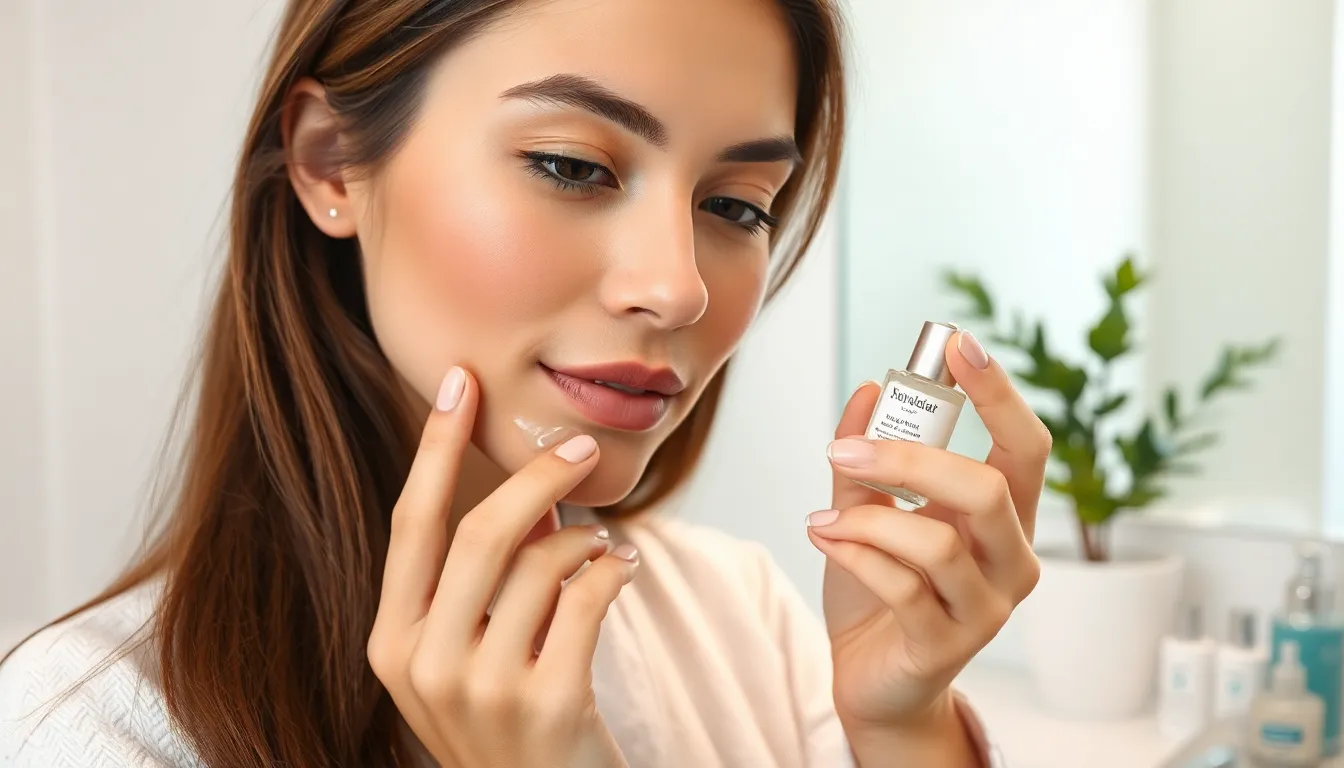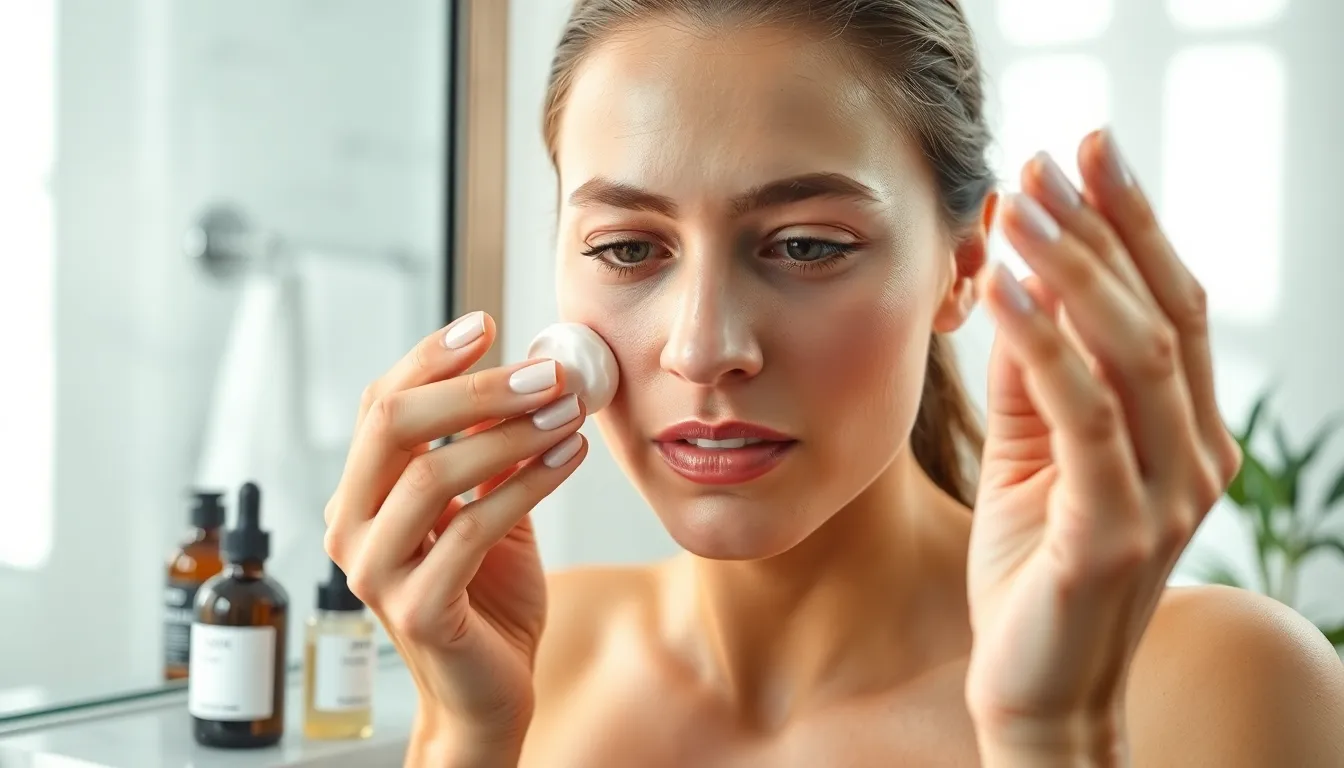Dealing with dry skin can feel like an endless battle against flakiness, tightness, and uncomfortable irritation. We’ve all experienced that frustrating moment when our skin looks dull and feels rough even though trying countless products that promise miracle results.
The truth is, most people approach dry skin care all wrong. They either skip essential steps or use products that actually strip away precious moisture. We’re here to change that narrative with a proven skincare routine that actually works.
Our comprehensive step-by-step approach focuses on rebuilding your skin’s natural moisture barrier while providing long-lasting hydration. You’ll discover the exact sequence of products to use, when to apply them, and which ingredients make the biggest difference for parched skin. Get ready to transform your complexion from dry and lackluster to smooth, supple, and radiant.
Step 1: Start With a Gentle Cleanser to Remove Impurities
Starting your dry skin routine with the right cleanser sets the foundation for everything that follows. We’re about to transform your cleansing approach to protect and nourish your skin’s delicate moisture barrier.
Choose Cream-Based or Oil-Based Cleansers
Cream-based cleansers work best for dry skin because they don’t strip away natural oils like traditional foaming formulas. We recommend looking for ingredients such as ceramides, glycerin, and hyaluronic acid that attract moisture while removing dirt and makeup. Oil-based cleansers dissolve impurities without disrupting your skin’s protective lipid layer.
Micellar water serves as an excellent gentle alternative for those who prefer a lighter cleansing experience. These formulas use tiny oil molecules called micelles to lift away debris without requiring harsh rubbing or multiple rinses.
Avoid Harsh Sulfates and Alcohol-Based Products
Sulfates like sodium lauryl sulfate create that satisfying foam but damage your skin’s moisture barrier in the process. We’ve seen countless people unknowingly worsen their dry skin by using cleansers containing these aggressive detergents. Alcohol-based products evaporate quickly and take your skin’s natural moisture with them.
Fragrance and essential oils can also trigger irritation in already compromised dry skin. Check ingredient lists carefully and opt for fragrance-free formulations whenever possible to minimize potential reactions.
Use Lukewarm Water Instead of Hot Water
Hot water feels relaxing but strips your skin of essential oils and proteins that keep it hydrated. We recommend using lukewarm water that feels comfortable to the touch rather than steamy or scalding temperatures. This simple temperature adjustment can prevent the tight, uncomfortable feeling that often follows cleansing.
Limit your cleansing time to 30-60 seconds to minimize water exposure. Pat your skin dry with a clean towel instead of rubbing vigorously to preserve the moisture you’ve worked to maintain.
Step 2: Apply a Hydrating Toner to Prep Your Skin

After cleansing your skin properly, we need to restore moisture and prepare your skin for the next skincare routine steps. Hydrating toners bridge the gap between cleansing and moisturizing while balancing your skin’s pH levels.
Look for Alcohol-Free Formulas With Hyaluronic Acid
Alcohol-free toners prevent further drying of your already compromised skin barrier. Traditional toners containing alcohol strip away essential moisture and can worsen dry skin conditions by disrupting your skin’s natural protective layer.
Hyaluronic acid stands out as the most effective ingredient for dry skin toners because it can hold up to 1,000 times its weight in water. This powerful humectant draws moisture from the environment and deeper skin layers to the surface, creating an instant plumping effect.
Formulas with hyaluronic acid help retain moisture throughout the day by forming a protective film on your skin’s surface. We recommend checking ingredient lists carefully and choosing toners that list hyaluronic acid within the first five ingredients for maximum effectiveness.
Use the Pat Don’t Rub Application Method
Patting motions preserve your skin’s delicate moisture barrier while ensuring even product distribution across your face and neck. Rubbing or wiping can cause micro-tears in dry skin and lead to irritation or increased sensitivity.
Gentle patting helps avoid irritation that commonly occurs when people apply toner too aggressively. Use your fingertips or palms to press the toner into your skin with light, upward motions.
Even absorption occurs when you pat the product systematically across different areas of your face. Start from the center of your face and work outward, paying special attention to particularly dry areas like your cheeks and forehead.
Consider Essence Type Toners for Extra Moisture
Essence type toners provide additional moisture beyond what regular toners offer, making them ideal for severely dry skin conditions. These hybrid products combine the pH-balancing benefits of toners with the intensive hydration of essences.
Enhanced effectiveness of subsequent skincare products results from using essence toners because they create a moisture-rich foundation. Your serums and moisturizers absorb better when applied over properly hydrated skin.
Multiple layers of hydration can be achieved by applying essence toners in thin layers, allowing each layer to absorb before adding the next. This technique, known as the “7-skin method,” maximizes moisture retention without overwhelming your skin.
Step 3: Incorporate a Nourishing Serum for Deep Hydration

Serums represent the powerhouse step that transforms dry skin from parched to plump. We’re focusing on deep hydration that penetrates beyond surface level moisture.
Target Ingredients Like Hyaluronic Acid and Ceramides
Hyaluronic acid stands as the ultimate moisture magnet for dry skin routines. This ingredient attracts up to 1,000 times its weight in water, creating an instant plumping effect that reduces fine lines and restores skin’s bounce. We recommend looking for serums containing multiple molecular weights of hyaluronic acid to ensure both surface and deeper skin layer hydration.
Ceramides work differently by strengthening your skin’s natural barrier function. These lipid molecules fill gaps between skin cells, preventing moisture loss and protecting against environmental damage. Research shows that ceramide-rich serums help restore the skin barrier within 2-4 weeks of consistent use.
Glycerin enhances the effectiveness of both hyaluronic acid and ceramides by drawing moisture from the environment into your skin. This humectant ingredient works best in moderate humidity levels and pairs perfectly with occlusive moisturizers that follow in your routine.
Apply Serum to Slightly Damp Skin
Timing your serum application maximizes hydration benefits for dry skin types. We apply serums within 60 seconds of toning while skin remains slightly damp, as this moisture helps carry active ingredients deeper into the skin layers.
Technique matters when applying hydrating serums to dry skin. Gently press the serum into skin using upward motions, starting from the center of your face and working outward. This method ensures even distribution without pulling or stretching delicate dry skin.
Amount should be appropriate for your skin’s absorption capacity. Most people need 2-3 drops of serum for the entire face, though severely dry skin may require up to 4-5 drops for complete coverage and optimal hydration.
Layer Multiple Serums From Thinnest to Thickest
Sequencing multiple serums requires following the thin-to-thick consistency rule for maximum absorption. Water-based serums with hyaluronic acid go first, followed by slightly thicker serums containing ceramides or peptides.
Wait time between serum layers allows each product to absorb properly without diluting the next application. We recommend waiting 30-60 seconds between layers, just until the previous serum no longer feels wet on your skin surface.
Compatibility between serum ingredients ensures you’re not creating conflicts that reduce effectiveness. Hyaluronic acid pairs well with ceramides, niacinamide, and vitamin C, while retinol-based serums work best as standalone treatments in evening routines for dry skin.
Step 4: Lock in Moisture With a Rich Moisturizer

After applying your nourishing serum, we’re ready to seal everything in with the most crucial step for dry skin. This final layer creates a protective barrier that prevents water loss and maintains the hydration we’ve built up through the previous steps.
Choose Cream-Based Over Lotion Formulas
Cream-based moisturizers deliver superior hydration for dry skin compared to lighter lotion formulas. These thicker formulations contain higher concentrations of emollients and occlusives that create an effective barrier against moisture loss. Water content in creams typically ranges from 20-30%, while lotions contain 60-80% water, making creams more intensive for severely dry skin conditions.
Texture matters significantly when we’re dealing with compromised skin barriers. Creams provide longer-lasting protection because their heavier consistency stays on the skin’s surface longer, allowing active ingredients to penetrate deeply. Most dermatologists recommend cream formulas specifically for dry skin types because they offer sustained moisture release throughout the day.
Focus on Ingredients Like Shea Butter and Glycerin
Shea butter stands out as one of the most effective natural moisturizing ingredients for repairing dry, damaged skin. This ingredient contains concentrated fatty acids and natural vitamins that help restore the skin’s protective barrier while providing anti-inflammatory benefits. Studies show shea butter can reduce skin irritation by up to 40% when used consistently in dry skin routines.
Glycerin acts as a powerful humectant that attracts moisture from the environment directly to your skin’s surface. This ingredient can hold up to 1,000 times its weight in water, making it essential for maintaining hydration levels throughout the day. We recommend looking for moisturizers containing at least 5% glycerin concentration for optimal moisture retention.
Combined together, these ingredients create a synergistic effect that addresses both immediate hydration needs and long-term skin barrier repair. Shea butter provides the occlusive protection while glycerin ensures continuous moisture attraction.
Don’t Forget Your Neck and Décolletage
Extending moisturizer application beyond your face ensures comprehensive skin hydration across all exposed areas. The neck and décolletage areas contain fewer sebaceous glands than facial skin, making them particularly susceptible to dryness and premature aging. These areas often show signs of dehydration first because they’re frequently neglected in daily skincare routines.
Apply moisturizer using upward strokes from your chest to your jawline to ensure even coverage. The skin on your neck is approximately 40% thinner than facial skin, requiring the same level of attention and protection. We suggest using about half the amount of product you’d use on your face for adequate coverage of both neck and chest areas.
Remember to apply your moisturizer within three minutes of your serum application while your skin is still slightly damp. This timing maximizes the occlusive benefits and locks in the hydrating layers we’ve carefully built up through each previous step.
Step 5: Protect Your Skin With Broad-Spectrum Sunscreen

Daily sun protection completes our dry skin routine by shielding your moisture barrier from harmful UV damage. Broad-spectrum sunscreen prevents further dehydration while maintaining the hydration we’ve built through our previous steps.
Use SPF 30 or Higher Daily
Apply broad-spectrum sunscreen with SPF 30 or higher every single day to protect your dry skin from UV rays that can worsen dehydration. Dermatological research confirms that SPF 30 blocks approximately 97% of UVB rays, making it the minimum protection level for maintaining healthy skin barrier function.
Choose sunscreens specifically formulated for dry skin that contain hydrating ingredients alongside UV protection. Look for products that combine sun protection with moisturizing benefits to avoid adding another drying layer to your routine.
Make sunscreen application a non-negotiable morning habit by applying it as the final step in your skincare routine. UV exposure occurs even on cloudy days and through windows, making daily protection essential for preventing moisture loss and premature aging.
Reapply Every Two Hours When Outdoors
Reapply sunscreen every two hours when spending time outdoors to maintain consistent protection throughout the day. Sun exposure breaks down sunscreen effectiveness, leaving your dry skin vulnerable to UV damage that can compromise your moisture barrier.
Set phone reminders or use sunscreen with built-in timers to ensure you don’t forget reapplication during outdoor activities. Extended sun exposure without proper reapplication can undo the hydrating work you’ve accomplished with your morning routine.
Carry a portable sunscreen stick or spray for easy reapplication over makeup or throughout busy days. Quick reapplication methods help maintain protection without disrupting your skincare routine’s moisture-building effects.
Choose Mineral Sunscreens for Sensitive Dry Skin
Opt for mineral sunscreens containing zinc oxide or titanium dioxide as these physical blockers are gentler on sensitive dry skin compared to chemical formulations. Mineral sunscreens sit on top of the skin rather than absorbing into it, reducing the risk of irritation while providing effective protection.
Select mineral sunscreens with lower risk of irritation since they don’t contain the harsh chemicals that can further dry out already compromised skin. These physical sunscreens work immediately upon application without requiring absorption time.
Look for mineral formulations that include moisturizing ingredients like ceramides or hyaluronic acid to provide dual benefits of protection and hydration. Many mineral sunscreens now combine sun protection with skincare benefits, making them ideal for dry skin maintenance routines.
Step 6: Add Weekly Treatments for Extra Nourishment

Building on your daily routine, weekly treatments provide the extra boost dry skin needs to stay healthy and hydrated. These intensive care steps work deeper than daily products to repair and restore your skin’s moisture barrier.
Use Hydrating Face Masks Once or Twice Per Week
Hydrating face masks deliver concentrated moisture that penetrates deeper than daily moisturizers. Apply these treatments 1-2 times weekly to give your skin an intensive hydration boost that lasts for days.
Choose masks containing hyaluronic acid, glycerin, and ceramides for maximum moisture retention. These ingredients work together to plump your skin while strengthening its natural barrier function.
Sheet masks offer convenient application and stay moist longer than cream masks. Leave them on for 15-20 minutes to allow your skin to absorb the full benefits of the hydrating ingredients.
Cream-based masks provide richer formulations that coat dry skin with nourishing oils and butters. Apply a thick layer and leave on for 10-15 minutes before gently removing with a warm, damp cloth.
Timing matters when using hydrating masks – apply them after cleansing but before your regular serum and moisturizer routine. This allows the mask’s active ingredients to penetrate clean skin while ensuring you seal in the benefits with your usual products.
Incorporate Gentle Exfoliation With Chemical Exfoliants
Chemical exfoliants remove dry, flaky skin more gently than physical scrubs that can damage sensitive dry skin. Use lactic acid or polyhydroxy acids (PHAs) once weekly to slough away dead skin cells without causing irritation.
Lactic acid works as an alpha hydroxy acid that dissolves the bonds between dead skin cells while providing mild hydrating benefits. Start with a 5% concentration and apply it only once per week to avoid over-exfoliation.
Polyhydroxy acids offer the gentlest exfoliation option for extremely dry or sensitive skin types. These larger molecules work more slowly than other acids, reducing the risk of irritation while still improving skin texture.
Apply chemical exfoliants to clean, dry skin in the evening after cleansing but before serums. Wait 10-15 minutes before continuing with your regular routine to allow the acids to work effectively.
Skip exfoliation if your skin feels particularly dry or irritated that week. Listen to your skin’s needs and adjust frequency based on how well your skin tolerates these treatments.
Try Overnight Sleeping Masks for Intensive Repair
Overnight sleeping masks work while you sleep to provide 8 hours of continuous hydration and repair. These leave-on treatments create an occlusive layer that prevents moisture loss throughout the night.
Apply sleeping masks as the last step in your evening routine after moisturizer for extra dry skin days. Use them 2-3 times per week or whenever your skin needs additional overnight nourishment.
Look for sleeping masks with ceramides and squalane that support skin barrier restoration during your body’s natural repair cycle. These ingredients work synergistically to rebuild damaged moisture barriers while you rest.
Gel-based sleeping masks suit those who prefer lighter textures that won’t transfer to pillowcases. Cream sleeping masks provide richer hydration for severely dry skin that needs maximum overnight moisture.
Wake up to noticeably softer, more supple skin after using overnight treatments consistently. Most people see improvements in skin texture and hydration levels within 2-3 weeks of regular use.
Step 7: Maintain Consistency and Track Your Progress

Building lasting results with your dry skin routine requires dedication and careful monitoring. We’ll show you how to create sustainable habits that deliver the hydrated, healthy skin you’re working toward.
Establish Morning and Evening Routines
Morning routines should focus on protection and hydration to prepare your skin for daily environmental stressors. Start with your gentle cleanser, follow with alcohol-free toner, apply hydrating serum, lock in moisture with your rich moisturizer, and finish with broad-spectrum sunscreen SPF 30 or higher.
Evening routines emphasize cleansing and repair to help your skin recover overnight. Begin by removing the day’s buildup with your cream-based cleanser, restore pH balance with hydrating toner, apply targeted treatments like hyaluronic acid serums, and seal everything with your nourishing moisturizer.
Creating distinct AM and PM routines ensures your skin receives continuous care throughout the 24-hour cycle. Different formulations work better at exact times, with morning products offering protection while evening treatments focus on intensive repair and regeneration.
Give Products 4-6 Weeks to Show Results
Skin cell turnover takes approximately 28 days, meaning you need consistent product use for at least 4 to 6 weeks to properly evaluate effectiveness. Rushing to judge new products after just a few days prevents you from seeing their true potential.
Hyaluronic acid serums and ceramide-rich moisturizers need time to rebuild your skin’s moisture barrier and improve hydration levels. Many people make the mistake of switching products too quickly, never allowing their skin to fully adapt and show improvement.
Patience becomes your greatest asset during this evaluation period. Document any changes you notice weekly rather than daily, as subtle improvements often compound over time to create important transformation.
Keep a Skincare Journal to Monitor Improvements
Track your skin’s response by noting daily observations about hydration level, texture changes, irritation incidents, and overall comfort. Write down which products you used, weather conditions, hormonal changes, and any lifestyle factors that might affect your skin.
Weekly assessments provide better insight than daily evaluations since skin improvements happen gradually. Note improvements in dryness, reduced flaking, enhanced smoothness, and increased comfort throughout the day.
Recording your observations helps identify patterns and product effectiveness over time. This documentation becomes invaluable when determining which ingredients work best for your exact dry skin needs and guides future routine adjustments.
Conclusion
Following these seven essential steps consistently will transform your dry skin from dull and flaky to smooth and radiant. We’ve outlined a comprehensive approach that addresses every aspect of dry skin care – from gentle cleansing to protective sunscreen application.
Remember that skincare isn’t a quick fix. The key to success lies in patience and consistency with your routine. Your skin barrier needs time to rebuild and strengthen so give these products and techniques at least 4-6 weeks to show their full potential.
Track your progress along the way and don’t be afraid to make small adjustments based on how your skin responds. With dedication to this proven routine you’ll finally achieve the hydrated healthy complexion you’ve been seeking.
Frequently Asked Questions
What is the most common mistake people make when caring for dry skin?
The most common mistake is skipping crucial steps in their skincare routine or using harsh products that damage the skin’s moisture barrier. Many people use sulfate-based cleansers and alcohol-containing products that strip away natural oils, making dryness worse. Additionally, rushing through the routine without allowing proper absorption time between products reduces effectiveness.
How long should I cleanse my face if I have dry skin?
You should limit cleansing time to 30-60 seconds using lukewarm water. Prolonged cleansing can strip essential oils from your skin, worsening dryness. Use gentle, cream-based or oil-based cleansers with hydrating ingredients like ceramides and glycerin. After cleansing, gently pat your skin dry instead of rubbing to preserve moisture.
What ingredients should I look for in products for dry skin?
Key ingredients include hyaluronic acid (attracts moisture), ceramides (strengthen skin barrier), glycerin (maintains hydration), and shea butter (provides deep nourishment). Avoid harsh sulfates, alcohol-based products, and fragrances that can irritate dry skin. Choose cream-based formulations over lighter lotions for superior hydration and barrier protection.
How do I apply skincare products correctly for dry skin?
Apply products to slightly damp skin within 60 seconds of the previous step for maximum absorption. Use the pat-don’t-rub method to preserve your moisture barrier. Layer products from thinnest to thickest consistency, allowing proper absorption between each application. Apply moisturizer within three minutes of serum application for optimal hydration benefits.
What is the 7-skin method mentioned in dry skin care?
The 7-skin method involves applying multiple thin layers of hydrating toner or essence to maximize moisture retention. You pat on several layers of alcohol-free, hyaluronic acid-containing toner, allowing each layer to absorb before applying the next. This technique provides enhanced hydration without overwhelming the skin or causing product pilling.
How often should I use weekly treatments for dry skin?
Use hydrating face masks once or twice a week, focusing on formulas with hyaluronic acid, glycerin, and ceramides. Incorporate gentle chemical exfoliants like lactic acid weekly to remove dead skin cells. Overnight sleeping masks can be used 2-3 times per week for intensive hydration and barrier repair while you sleep.
How long does it take to see results from a dry skin routine?
Give your skincare routine 4-6 weeks to show noticeable results, as skin cell turnover takes time. Keep a skincare journal to track improvements and identify which products work best for your skin. Consistency is crucial – establish distinct morning and evening routines and stick to them daily for optimal results.
What type of sunscreen should I use for dry skin?
Choose broad-spectrum sunscreen with SPF 30 or higher that includes hydrating ingredients. Mineral sunscreens containing zinc oxide or titanium dioxide are gentler on sensitive dry skin. Look for formulations that combine sun protection with moisturizing properties. Reapply every two hours when outdoors to maintain consistent protection and prevent dehydration.







